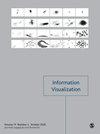PeaGlyph:用于研究平衡数据结构的Glyph设计
IF 1.8
4区 计算机科学
Q3 COMPUTER SCIENCE, SOFTWARE ENGINEERING
引用次数: 3
摘要
对于许多数据分析任务,例如为公平竞争或学习环境中的合作组建平衡良好的小组,数据属性之间的平衡至少与项目的实际价值一样重要。同时,这些任务隐含地需要对值进行比较。即使有可用的统计方法来衡量平衡水平,人类的判断和领域专业知识在判断平衡水平以及不平衡水平是否可接受方面也发挥着重要作用。因此,需要在群体形成的背景下改进决策的技术,这些技术可以用作统计分析的视觉补充。本文介绍了一种新的基于字形的可视化,PeaGlyph,旨在支持对平衡和不平衡数据结构的理解,例如通过使用可计数标记和显著形状特征的频率格式。字形是专门为研究平衡和不平衡组的特性的相关任务设计的,例如查找和比较值。基于Glyph的可视化方法为探索和分析多变量数据集提供了灵活而有用的抽象。PeaGlyph的设计基于一项初步研究,该研究在一项联合研究中比较了四种字形可视化方法,包括两种基本字形及其变体。通过评估,将小说《豌豆雕文》的表现与第一项研究中表现最好的“演员”进行了比较。该研究的初步结果令人鼓舞,所提出的设计可能是传统字形的一个很好的替代方案,用于描绘多元数据,并允许观众对一组对象的平衡或不平衡程度形成直观印象。此外,在字形设计的背景下讨论了一组设计注意事项。本文章由计算机程序翻译,如有差异,请以英文原文为准。
PeaGlyph: Glyph design for investigation of balanced data structures
For many data analysis tasks, such as the formation of well-balanced groups for a fair race or collaboration in learning settings, the balancing between data attributes is at least as important as the actual values of items. At the same time, comparison of values is implicitly desired for these tasks. Even with statistical methods available to measure the level of balance, human judgment, and domain expertise plays an important role in judging the level of balance, and whether the level of unbalance is acceptable or not. Accordingly, there is a need for techniques that improve decision-making in the context of group formation that can be used as a visual complement to statistical analysis. This paper introduces a novel glyph-based visualization, PeaGlyph, which aims to support the understanding of balanced and unbalanced data structures, for instance by using a frequency format through countable marks and salient shape characteristics. The glyph was designed particularly for tasks of relevance for investigation of properties of balanced and unbalanced groups, such as looking-up and comparing values. Glyph-based visualization methods provide flexible and useful abstractions for exploring and analyzing multivariate data sets. The PeaGlyph design was based on an initial study that compared four glyph visualization methods in a joint study, including two base glyphs and their variations. The performance of the novel PeaGlyph was then compared to the best “performers” of the first study through evaluation. The initial results from the study are encouraging, and the proposed design may be a good alternative to the traditional glyphs for depicting multivariate data and allowing viewers to form an intuitive impression as to how balanced or unbalanced a set of objects are. Furthermore, a set of design considerations is discussed in context of the design of the glyphs.
求助全文
通过发布文献求助,成功后即可免费获取论文全文。
去求助
来源期刊

Information Visualization
COMPUTER SCIENCE, SOFTWARE ENGINEERING-
CiteScore
5.40
自引率
0.00%
发文量
16
审稿时长
>12 weeks
期刊介绍:
Information Visualization is essential reading for researchers and practitioners of information visualization and is of interest to computer scientists and data analysts working on related specialisms. This journal is an international, peer-reviewed journal publishing articles on fundamental research and applications of information visualization. The journal acts as a dedicated forum for the theories, methodologies, techniques and evaluations of information visualization and its applications.
The journal is a core vehicle for developing a generic research agenda for the field by identifying and developing the unique and significant aspects of information visualization. Emphasis is placed on interdisciplinary material and on the close connection between theory and practice.
This journal is a member of the Committee on Publication Ethics (COPE).
 求助内容:
求助内容: 应助结果提醒方式:
应助结果提醒方式:


